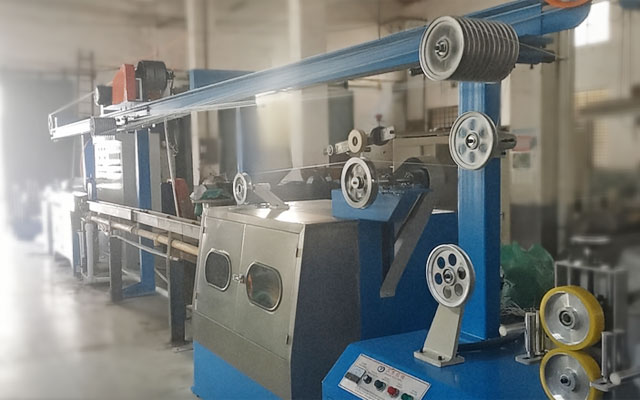Model 30-90Screw Diameter φ30-90 mmL/D Ratio 26:1/25:1Extrusion Output 25-250 kg/hMain Motor 18-63 KWOutlet Diameter 0.2-35 mmSpeed 10-600 m/minApplication Tugboat towline extrusion line
Tugboat Towline Extrusion Line
A tugboat towline extrusion production line is a highly specialized industrial system designed for the continuous coating of high-strength synthetic fiber ropes or steel wire ropes used as tugboat towlines. Its core process involves applying a uniform, durable layer of polymer material, primarily polyethylene (PE) or polypropylene (PP), onto the rope core via hot extrusion.
This extruded polymer sheath acts as a "protective armor" for the towline. It is engineered to withstand the extreme operational demands of towing, offering superior resistance to abrasion, seawater immersion, UV degradation, and mechanical fatigue. The final plastic-coated towline exhibits significantly enhanced service life, operational safety, and reliability compared to uncoated alternatives.
Main Characteristics of the Production Line:Continuous Operation: Integrates pay-off, preheating, extrusion, cooling, traction, and take-up into a seamless, automated process for high efficiency.
High-Performance Coating: Utilizes high pressure and precision tooling to ensure the molten polymer forms a dense, uniform, and tightly bonded protective layer around the core.
Superior Adhesion: Employs process controls like core preheating to achieve excellent adhesion between the sheath and the rope, preventing slippage or delamination under load.
Core Components of the Production LineA complete tugboat towline extrusion production line typically consists of the following key units:
Pay-Off SystemFunction: To hold and dispense the uncoated rope reel in a controlled and steady manner.
Composition: Large-capacity spools or turntables equipped with brakes and a tension control system to maintain consistent tension and prevent slack or over-stretching.
Preheating SystemFunction: To heat the rope core immediately before it enters the extrusion die.
Importance: Preheating removes surface moisture and elevates the core's temperature, which is critical for promoting strong bonding, reducing internal stresses, and preventing sheath cracking or separation after cooling.
Plastic ExtruderFunction: The "heart" of the line, responsible for melting, homogenizing, and metering the polymer material.
Composition:
Hopper: For feeding plastic pellets.
Barrel and Screw: The core components where material is plasticized through shear heat and external heaters.
Heating/Cooling Bands: Precisely regulate temperature zones along the barrel.
Drive Motor: Provides power to rotate the screw.
Extrusion Die (Crosshead)Function: A critical component that shapes the polymer melt and applies it concentrically around the moving rope core.
Composition: Typically a crosshead die with intricate flow channels designed to ensure a uniform, concentric coating application.
Cooling SystemFunction: To rapidly solidify the molten polymer sheath after it exits the die.
Form: Consists of one or more cascading water tanks. Staged cooling (e.g., misting followed by immersion) controls the cooling rate to minimize internal stresses and deformation.
Traction SystemFunction: To provide the primary pulling force, driving the rope through the line at a constant, controlled speed.
Composition: Often comprises synchronized rubber caterpillar tracks or wheels that grip the coated rope without slipping. Its speed stability is crucial for coating thickness consistency.
Take-Up SystemFunction: To wind the finished plastic-coated towline neatly and tightly onto a storage reel.
Composition: A powered take-up machine with a traversing mechanism for even winding and tension control to ensure a stable, transportable package.
Electrical Control SystemFunction: The "brain" of the operation.
Composition: Centered on a PLC (Programmable Logic Controller), HMI (Human-Machine Interface), temperature controllers, and drives. It integrates control over all machine functions, synchronization, and process parameters for automated, precise production.
Tugboat Towline Extrusion Line Datasheet
| Model |
30 |
40 |
50 |
60 |
70 |
80 |
90 |
| Screw Diameter (mm) |
φ30 |
φ40 |
φ50 |
φ60 |
φ70 |
φ80 |
φ90 |
| Screw L/D Ratio |
25:1 |
25:1 |
26:1 |
26:1 |
26:1 |
26:1 |
26:1 |
| Extrusion Amount (kg/hr) |
25 |
40 |
70 |
100 |
140 |
200 |
250 |
| Outlet Wire (mm) |
0.2-1 |
0.4-3 |
0.8-5 |
1-8 |
2-15 |
3-25 |
5-35 |
| Total Power (KW) |
18 |
20 |
25 |
33 |
40 |
55 |
63 |
| Traction Power (KW) |
2.2 |
2.2 |
4 |
4 |
4 |
5.5 |
5.5 |
| Production Speed (m/min (Max.)) |
600 |
600 |
600 |
500 |
500 |
300 |
300 |
| Take-up Spool (mm) |
φ200-400 |
φ300-500 |
φ400-630 |
φ400-630 |
φ500-630 |
φ800-1000 |
φ1000-1250 |
Tugboat Towline Extrusion Line Application
The plastic-coated towlines produced by this line are essential for modern maritime towing operations due to their exceptional durability and performance.
Core Application: Tugboat TowlinesFunction: Used by tugboats for towing, pushing, and maneuvering other vessels, barges, or offshore structures.
Advantages:
Exceptional Abrasion Resistance: The sheath protects the core from wear against the seafloor, vessel hulls, and fairleads.
Corrosion and Rot Prevention: Provides a complete barrier against seawater, salt spray, and for synthetic fibers, prevents moisture ingress and microbial degradation.
UV and Weather Resistance: The polymer material is formulated to resist degradation from sunlight and harsh weather, maintaining integrity over time.
Enhanced Safety: A visible, intact sheath makes it easier to inspect the line for external damage and helps contain core fragments in the rare event of a break.
Improved Handling: The coated surface is smoother, resists kinking, and is easier to handle and spool.


